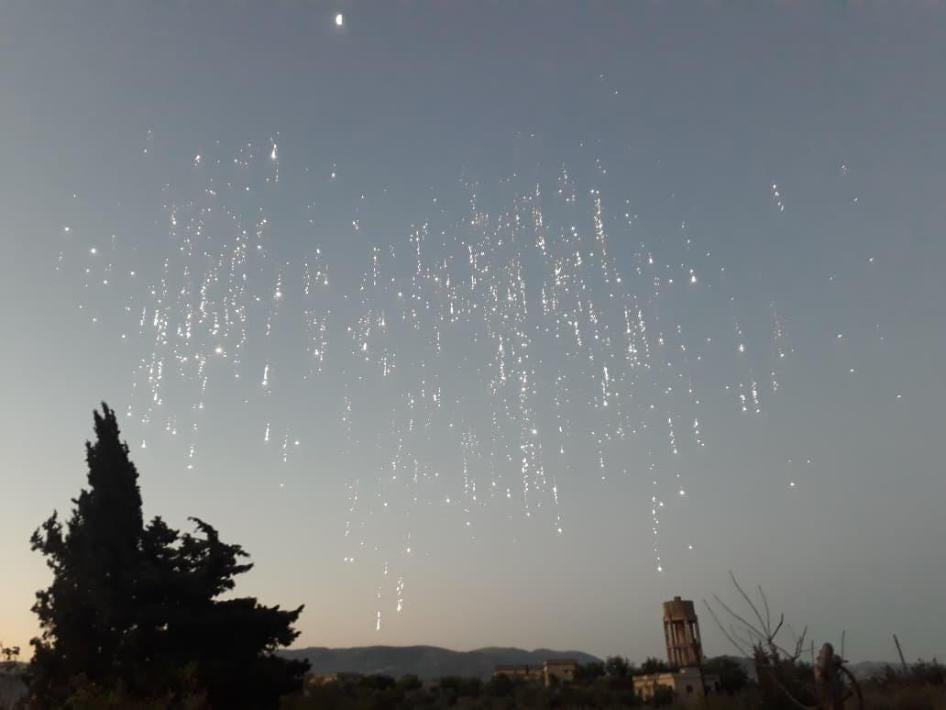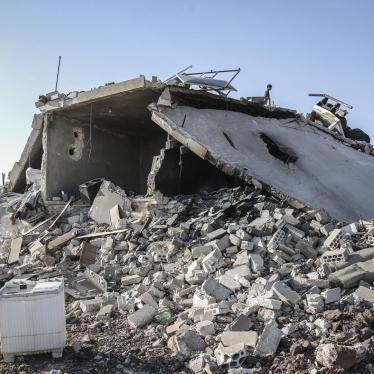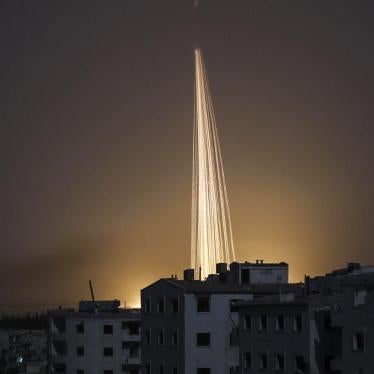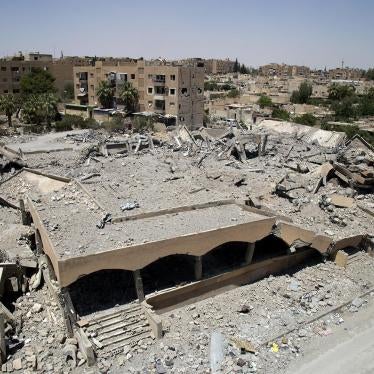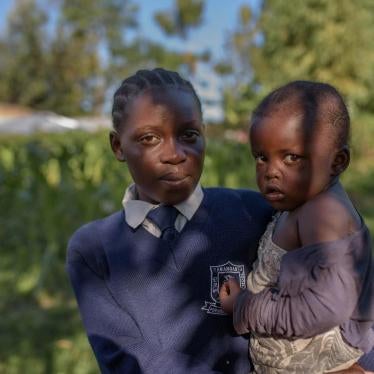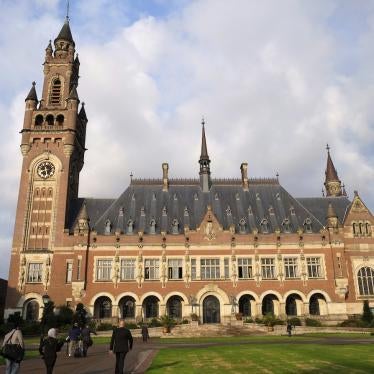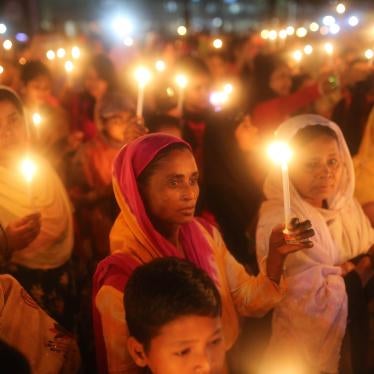Ten years ago, images of white phosphorus munitions raining fire on populated areas of Gaza generated international outrage and sparked discussions of incendiary weapons at the United Nations. The Israel Defense Forces’ use of white phosphorus in January 2009 caused civilian casualties and damaged civilian structures, including a school, market, humanitarian aid warehouse, and hospital.[1] At the following year’s Meeting of States Parties to the Convention on Conventional Weapons (CCW), several states condemned the attacks and highlighted the shortcomings of CCW Protocol III, which governs incendiary weapons.[2] Since then, as use of incendiary weapons has spread to other conflicts, including in Syria and Ukraine, calls to review the protocol’s adequacy and strengthen its humanitarian protections have increased.
Incendiary weapons, which start fires and burn people, are notorious for the severity of the immediate and long-term injuries they cause. Adopted in 1980, Protocol III regulates the use of incendiary weapons, but its efficacy as a humanitarian instrument is limited by two key loopholes. First, its design-based definition arguably excludes certain multipurpose munitions with incendiary effects, notably those with white phosphorus. Second, the protocol contains weaker restrictions for ground-launched incendiary weapons than air-dropped versions, even though all such weapons cause horrific harm.
After years of slow but steady progress, efforts to strengthen international law on incendiary weapons took a step backwards at the CCW’s annual meeting in November 2018. Russia took advantage of the desire for consensus and blocked the widely supported proposal to continue dedicated discussions of incendiary weapons under a separate agenda item at the CCW’s November 2019 meeting. Meanwhile, in Syria, the Syrian-Russian military alliance continued its use of incendiary weapons in or near civilian areas.
Despite this setback, CCW states parties should continue to speak out on incendiary weapons and demand time for a reassessment of Protocol III. Indeed, they should intensify their work on the topic now so that they are prepared to take concrete action at the 2021 CCW Review Conference. In particular, they should:
- Condemn ongoing use of incendiary weapons;
- Express their views on the adequacy of Protocol III during the general debate or the session on the status and operation of the protocols;
- Work to close Protocol III’s loopholes and further stigmatize the use of incendiary weapons. A complete ban on incendiary weapons would have the greatest humanitarian benefits; and
- Set aside time in 2020 for an in-depth discussion of the implementation and adequacy of Protocol III, with an eye to agreeing to amend the instrument at the 2021 Review Conference.
Incendiary Weapons and the Harm They Cause
Incendiary weapons produce heat and fire through the chemical reaction of a flammable substance.[3] They can be used to burn people or material or to penetrate plate metal. Due to their extreme heat, incendiary weapons can cause severe fourth-degree or even fifth-degree burns, often killing or physically and psychologically scarring their victims.[4] Survivors face an array of other short-term and long-term consequences, including but not limited to: lingering respiratory problems from smoke inhalation, severe infection, shock, organ failure, muscle weakness, and lifelong disability. The disabilities and disfigurement caused by incendiary weapons sometimes lead to socioeconomic exclusion. The use of incendiary weapons also results in the destruction of homes, hospitals, schools, farmland, and other civilian infrastructure, and can cause displacement.
Although primarily designed to produce smokescreens and thus arguably not covered by Protocol III’s definition of incendiary weapons (see further discussion below), white phosphorus munitions operate in the same manner and produce the same effects as other incendiary weapons.[5] When white phosphorus comes into contact with skin, it inflicts intense and persistent burns, sometimes to the bone. Infection is common, and the body’s absorption of the chemical can cause serious damage to internal organs as well as death. Because white phosphorus burns on contact with oxygen, treated wounds can reignite when bandages are removed.
Protocol III and Its Loopholes
Protocol III seeks to protect civilians and civilian objects by regulating the use of incendiary weapons in “concentrations of civilians” and in “forests and other kinds of plant cover.”[6] Nevertheless, it contains two legal loopholes that reduce its effectiveness.
First, Protocol III’s definition of incendiary weapons arguably excludes most multipurpose incendiary munitions. According to Article 1(1), an incendiary weapon is “any weapon or munition which is primarily designed to set fire to objects or to cause burn injury to persons through the action of flame, heat, or combination thereof, produced by a chemical reaction of a substance delivered on the target.” The definition does not encompass munitions, like those containing white phosphorus, that set fires and cause burns but are “primarily designed” to create smokescreens or signal troops.[7] The nature or magnitude of impact or injury is not taken into account, as long as its primary purpose is considered beyond the scope of the protocol. The applicability of Protocol Ill thus depends largely on how developers, manufacturers, and users describe the purpose of a weapon.
Second, Protocol III draws an arbitrary and outdated distinction between air-dropped and ground-launched incendiary weapons. It prohibits the use of air-dropped models in concentrations of civilians, but the provision on the use of ground-launched incendiary weapons in such areas includes several caveats, falling short of a ban. This loophole ignores the reality that incendiary weapons cause the same horrific burns and destructive fires regardless of their delivery mechanism. In addition, ground-launched incendiary weapons, especially when delivered by multi-barrel rocket launchers, can have wide area effects comparable to air-dropped ones, which makes them dangerous to civilians when used in populated areas. Furthermore, non-state armed groups have greater access to ground-launched incendiary weapons and may feel less pressure not to use them if international law, and the resulting norm, is less than absolute.
It would be legally, if not politically, straightforward to close both these loopholes. Article 1(1) of Protocol III could be amended to redefine incendiary weapons as weapons that “have the effect of setting fires and causing burns….” Article 2 could be rewritten to prohibit the use of any incendiary weapon, regardless of its delivery mechanism, within a concentration of civilians. These changes would create stronger rules for states parties and increase the stigma against incendiary weapons, influencing even actors outside the treaty.
Ongoing Use in Syria
Ongoing use of incendiary weapons, including in concentrations of civilians, highlights the need for stronger international law. While the use of white phosphorus dominated discussions a decade ago, the intervening years have provided a reminder that other types of incendiary weapons are problematic as well.
Syrian government forces have been using incendiary weapons in concentrations of civilians in Syria since 2012.[8] Incendiary weapons attacks in Syria became more frequent after Russia began joint operations with Syrian government forces in September 2015. Syria has not joined CCW Protocol III, but Russia is a party and legally bound by its provisions.
Since November 2012, Human Rights Watch has identified about 150 incendiary weapons attacks by the Syrian-Russian military alliance in Syria. In May-June 2019 alone, it identified 27 uses of incendiary weapons. The total number of attacks is likely much higher because some go unreported and others are not recorded by visual media so cannot be investigated.
Most of the documented incendiary weapon attacks in 2019 took place in Idlib governorate. An attack on May 25 in Khan Sheikhoun, Idlib, for example, left approximately 175,000 square meters of farmland burned, according to Human Rights Watch’s analysis of satellite imagery.[9]
Human Rights Watch also documented this year six strikes in Hama governorate and one in the village of Tal Hadya near Aleppo. Ground-launched incendiary rockets account for almost all of the attacks recorded in 2019.
In 2018, two-thirds of the 30 incendiary weapons attacks documented by Human Rights Watch involved ground-launched models, but airstrikes also caused harm. For example, Syria Civil Defense reported that on March 16, 2018, an air attack with an RBK-500 bomb carrying ZAB incendiary submunitions killed at least 61 people and injured more than 200 in Kafr Batna in Eastern Ghouta.[10]
To make these identifications, Human Rights Watch reviewed videos and photographs of the use of incendiary weapons that were taken by the general public, first responders, and activists. The organization examined testimony and additional visual material from after attacks showing the effects of incendiary weapons and the remnants they left behind. Human Rights Watch also relied on satellite imagery analysis.
Human Rights Watch is also looking into the alleged use of white phosphorus in Syria by Turkey and its allies in October 2019, but it has not confirmed whether the allegations are true.[11]
Political Support despite Short-Term Setback
Since 2010, the use of incendiary weapons in Gaza, Iraq, Syria, Ukraine, Yemen, and elsewhere has generated debate at the CCW’s annual meetings. Over that period, at least 36 states, the European Union, and other international actors have publicly expressed their concern about the use of incendiary weapons and white phosphorus.[12] During the 2018 meeting, almost all of the 19 states that engaged in discussions about incendiary weapons expressed concerns and/or a desire to continue such discussions. Protocol III, however, was dropped from the 2019 agenda due to pressure from a few states, most vocally from Russia. Russia argued that any problems with the use of incendiary weapons were a result of poor implementation of the treaty and that continued discussions would have no added value.[13]
Condemnation and Concern
At least 11 states plus the European Union expressed concerns about or condemned the use of incendiary weapons on civilians since the beginning of the Syrian conflict.[14] Croatia emphasized the “gruesome effects of incendiary weapons on victims” as shown in coverage of hostilities in Syria.[15] New Zealand stated that it was “gravely concerned” about that use.[16] These states were joined by Australia, Austria, Germany, Ireland, Mexico, Montenegro, the United Kingdom, and the European Union in their disapproval.
The final report of the meeting reflected these views. It declared that a “number of High Contracting Parties raised concerns over the recent growing number of reports of use of incendiary weapons against civilians and condemned any use of incendiary weapons against civilians or civilian objects, and any other use incompatible with relevant rules of International Humanitarian Law, including the provisions of Protocol III, where applicable.”[17]
States have also expressed concern about the effects of incendiary weapons in other international fora. In a statement during the UN General Assembly’s First Committee on Disarmament and International Security in October 2019, the Non-Aligned Movement expressed “grave concern over the reported use in civilian areas of harmful and potentially fatal incendiary weapons such as white phosphorus.”[18]
Calls for Further Discussion
Most of the states that spoke during the 2018 annual CCW meeting supported the discussions of incendiary weapons and the inclusion of Protocol III on the agenda. The majority of these also explicitly called for further work. For example, Croatia urged states to use the CCW as the forum to “address observed shortcomings of Protocol III that arise from the challenges in implementation, universalization, technological advancements and evolution of the provisions of international humanitarian law.”[19] Switzerland, concerned with reports of the use of incendiary weapons, stated that “the distinction of delivery methods warrant an in-depth discussion about humanitarian considerations, military necessity and legal questions raised by the use of incendiary weapons and munitions whose effects may be similar.”[20]
Recognizing the need to spend more time discussing Protocol III, New Zealand called for Protocol III to remain on the agenda of the CCW’s annual meeting. It also “remain[ed] open to the convening of an informal meeting to discuss universalisation, implementation and adequacy of Protocol III in light of the humanitarian concerns that surround incendiary weapons.”[21] Such a meeting would be held outside of the formal Meeting of States Parties and would allow for even more in-depth discussions.
Looking forward, multiple states argued that Protocol III should be taken up at the 2021 Review Conference. Ireland said that “the continued applicability and relevance of Protocol III is an issue appropriate for further consideration at the next Review Conference.” Panama expressed that it was imperative for states to discuss ways to strengthen the protocol and close loopholes in preparation for the next Review Conference.[22]
International and nongovernmental organizations also welcomed the discussions and called for them to continue. The International Committee of the Red Cross urged states “to report on their national policies and operational practice with regard to the use of incendiary weapons, and of weapons with incidental incendiary effects, to help to inform discussions in the CCW regarding compliance with Protocol III, rules of customary IHL [international humanitarian law] applicable to incendiary weapons, and the general rules of IHL on the conduct of hostilities.”[23] Civil society organizations, including Human Rights Watch, Article 36, and PAX, called for both further discussions and amendments to strengthen Protocol III.
Strengthening or Amending Protocol III
In 2018, at least seven states specifically called for strengthening or amending Protocol III to close the loopholes that exist due to the protocol’s arbitrary and outdated distinctions.[24] Mexico advocated for expanding the scope of the protocol to include weapons with incendiary effects.[25] Argentina emphasized that Protocol III is limited because it does not “cover all uses of incendiary weapons,” and expressed its commitment to review and strengthen the protocol.[26] Recognizing that Protocol III distinguishes between different delivery mechanisms, the Holy See called for “an honest technical and legal review of the provisions contained in Protocol III in order to strengthen this instrument [so] as to remain relevant in today’s conflicts and enhance protections.”[27] Additionally, Chile said that Protocol III’s scope of application and definitions are of particular concern.[28] These states were joined by Austria, Croatia, and Panama.
Conclusion
The ongoing use of incendiary weapons underscores the need for stronger international law, and the statements made at last year’s CCW meeting show that there is an appetite for more in-depth consideration of the adequacy of Protocol III. States should seize the opportunity presented by the 2021 Review Conference to take concrete actions to increase the protection of civilians from incendiary weapons. They should not stand by until then, however. CCW states parties should set aside time for substantive discussions of the issue in 2020 in order to be fully prepared to initiate the process to amend Protocol III at the Review Conference.
[1] Human Rights Watch, Rain of Fire: Israel’s Unlawful Use of White Phosphorus in Gaza, March 2009, https://www.hrw.org/report/2009/03/25/rain-fire/israels-unlawful-use-white-phosphorus-gaza.
[2] Convention on Conventional Weapons (CCW) Protocol on Prohibitions or Restrictions on the Use of Incendiary Weapons (Protocol Ill), adopted October 10, 1980, 1342 U.N.T.S. 171, entered into force December 2, 1983.
[3] For more information on the harm caused by incendiary weapons, see Human Rights Watch and the Harvard Law School International Human Rights Clinic, An Overdue Review: Addressing Incendiary Weapons in the Contemporary Context, November 2017, http://hrp.law.harvard.edu/wp-content/uploads/2017/11/AnOverdueReview.pdf, pp. 3-5.
[4] UN Department of Political and Security Council Affairs, “Napalm and Other Incendiary Weapons and All Aspects of Their Possible Use: Report of the Secretary-General,” A/ 8803/Rev. 1, 1973, pp. 30–31.
[5] Although white phosphorus munitions are generally designed to produce smokescreens, armed forces have used them specifically for their incendiary properties, including when targeting people or material or “smoking out” sheltered persons in order to kill them with other weapons.
[6] CCW Protocol Ill, art. 2.
[7] Maj. Shane R. Reeves, a military officer and professor at the US Military Academy at West Point, interprets Protocol Ill to exclude white phosphorus when it is intended for something other than burning. Major Reeves explained: “[W]hen white phosphorus munitions are employed for a non-incendiary purpose,” such as to create a smokescreen, “the munitions clearly fall outside the definition of an ‘incendiary weapon’ and will not be regulated by Protocol Ill.” Even though “white phosphorous is at times employed solely because of its ‘incidental’ incendiary effects, thus essentially converting the munition into an incendiary weapon,” the current design-based definition in Protocol Ill ensures that white phosphorus escapes regulation. Maj. Shane R. Reeves, “The ‘Incendiary’ Effect of White Phosphorous in Counterinsurgency Operations,” The Army Lawyer (June 2010), https://ssrn.com/ abstract=2295118 (accessed November 1, 2019), p. 86.
[8] For more information on use of incendiary weapons in Syria, see Human Rights Watch and IHRC, An Overdue Review, November 20, 2017, https://www.hrw.org/news/2017/11/20/overdue-review-addressing-incendiary-weapons-contemporary-context, pp. 14-18.
[9] Human Rights Watch, “Russia/Syria: Flurry of Prohibited Weapons Attacks,” June 3, 2019, https://www.hrw.org/news/2019/06/03/russia/syria-flurry-prohibited-weapons-attacks.
[10] Syria Civil Defense, “A horrific massacre including unconscienable [sic] Napalm air strikes killed at least 61 civilians in #Kafr_Bata Town,” Twitter, March 16, 2018, https://twitter.com/SyriaCivilDef/status/974660689502629889 (accessed November 1, 2019).
[11] “Kurds Accuse Turkey of Using Napalm and White Phosphorus,” France 24, October 24, 2019, https://www.france24.com/en/20191017-kurds-accuse-turkey-of-using-napalm-and-white-phosphorus (accessed November 1, 2019).
[12] Argentina, Australia, Austria, Canada, Chile, Colombia, Costa Rica, Croatia, Cyprus, Djibouti, Ecuador, Estonia, Finland, France, the Holy See, Hungary, Ireland, Italy, Kazakhstan, Latvia, Lithuania, Mauritius, Mexico, Moldova, Montenegro, the Netherlands, New Zealand, Nigeria, Pakistan, Palestine, Slovenia, South Africa, Sweden, Switzerland, the United Kingdom, and the United States, as well as the European Union. See statements from CCW Meetings of States Parties and Review Conferences between 2010-2018, generally available at UN Office at Geneva, “The Convention on Certain Conventional Weapons: Meetings of the States Parties,” https://www.unog.ch/80256EE600585943/(httpPages)/4F0DEF093B4860B4C1257180004B1B30?OpenDocument (accessed November 1, 2019), and Reaching Critical Will, “Convention on Certain Conventional Weapons (CCW),” http://reachingcriticalwill.org/disarmament-fora/ccw (accessed November 1, 2019). See also Human Rights Watch notes from those meetings.
[13] Statement of Russia, CCW Meeting of States Parties, Geneva, November 22, 2018.
[14] Australia, Austria, Croatia, Germany, the Holy See, Ireland, Mexico, Montenegro, New Zealand, Switzerland, United Kingdom and the European Union. See statements from CCW Meeting of States Parties, 2018, generally available at UN Office at Geneva, “The Convention on Certain Conventional Weapons: Meetings of the States Parties,” and Reaching Critical Will, “Convention on Certain Conventional Weapons (CCW).” See also Human Rights Watch notes from those meetings.
[15] Statement of Croatia, CCW Meeting of States Parties, Geneva, November 21, 2018.
[16] Statement of New Zealand, CCW Meeting of States Parties, Geneva, November 22, 2018.
[17] CCW Meeting of High Contracting Parties, “Final Report,” CCW/MSP/2018/11, Geneva, December 28, 2018.
[18] Statement by Indonesia on behalf of the Non-Aligned Movement, First Committee, 74th Session, UN General Assembly, New York, November 22, 2019.
[19] Statement of Croatia, CCW Meeting of States Parties, Geneva, November 21, 2018.
[20] Statement of Switzerland, CCW Meeting of States Parties, Geneva, November 22, 2018.
[21] Statement of New Zealand, CCW Meeting of States Parties, Geneva, November 22, 2018.
[22] Statement of Panama, CCW Meeting of States Parties, Geneva, November 21, 2018 (IHRC translation).
[23] Statement of the International Committee of the Red Cross (ICRC), CCW Meeting of States Parties, Geneva, November 22, 2018.
[24] Argentina, Austria, Chile, Croatia, the Holy See, Mexico, and Panama discussed closing loopholes in Protocol III at the 2018 Meeting of States Parties. See statements from CCW Meeting of States Parties, 2018, generally available at UN Office at Geneva, “The Convention on Certain Conventional Weapons: Meetings of the States Parties,” and Reaching Critical Will, “Convention on Certain Conventional Weapons (CCW).” See also Human Rights Watch notes from those meetings.
[25] Statement of Mexico, CCW Meeting of States Parties, Geneva, November 21, 2018 (IHRC translation).
[26] Statement of Argentina, CCW Meeting of States Parties, Geneva, November 21, 2018.
[27] Statement of the Holy See, CCW Meeting of States Parties, Geneva, November 21, 2018.
[28] Statement of Chile, CCW Meeting of States Parties, Geneva, November 22, 2018.
